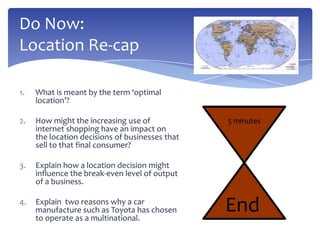
Optimal Location Factors
- 1. Do Now: Location Re-cap 1. What is meant by the term ‘optimal location’? 2. How might the increasing use of 5 minutes internet shopping have an impact on the location decisions of businesses that sell to that final consumer? 3. Explain how a location decision might influence the break-even level of output of a business. 4. Explain two reasons why a car manufacture such as Toyota has chosen to operate as a multinational. End
- 2. Operational Strategies: Lean Production
- 3. Learning Objectives By the end of the lesson you should be able to: 1. Identify a range of techniques associated with lean production and the benefits of use for larger businesses. 2. Interpret and complete critical path networks 3. Assess the benefits and limitations of critical path analysis.
- 4. Lean Production Techniques Production efficiency comes about as a result of making quality products at the lowest cost with as a little waste as possible. Firms do this by adopting lean production techniques. Can you solve these lean production techniques? TNJ-UIS-IMTE IANEKZ TIME-BASED ME-BSMEM JUST-IN-TIME KAIZEN MANAGEMENT AAINATGEDNTE
- 5. Just-in-time (JIT) JIT aims to reduce waste by limiting the stock holding at each stage of the production process. How does it work? Materials are delivered as required. Raw materials straight to the production process. Retail goods straight to the shop floor. In catering only food for that day is prepared.
- 6. Why would firms to do this? Think Pair Share Write down one Walk around the Share your ideas reason for and room until the with the rest of one reason music stops and the group. against share your ideas. Reasons FOR Reasons AGAINST • Minimise the cost of holding and • Can take time and money to storing stock introduce. • No obsolete or ruined stock. • Risk if long supply chain. • Possibly reduced insurance costs. • Systems have to be reviewed and • Made to order. new systems put in place. • Can lead to a competitive • Possible high staff training costs advantage. and may need to purchase new IT systems.
- 7. Kaizen Kaizen – is an approach to improving efficiency and performance through continual improvement. How does it work? Staff are empowered with the ability to What do you think are spot opportunities and make the potential recommendations for improvements. problems of Kaizan recognises that employees are implementing a better placed to make suggestions. successful Kaizen Employees are motivated and involved. programme? Smaller changes are easier to implement than larger ones.
- 8. Time-based Management For TBM the aim is to What are the benefits to the reduce time wasted or this method? unproductive time to improve efficiency. Write them down….. BENEFITS How does it work? Staff are trained to be able End 60 46 49 48 40 44 56 59 58 50 36 39 38 30 54 45 43 34 26 29 28 20 47 42 24 55 53 35 33 57 37 52 25 32 23 27 22 16 19 18 10 41 14 51 15 31 13 17 21 12 11 6 9 8 4 5 3 7 2 1 Quicker time to market. Improved ability to respond to perform a number of tasks. to changes in market conditions or consumer Flexibility in the production tastes. process is key.
- 9. Test what you know…. What is the lean production method that is based on reducing time wastage? Time-based Management Explain a benefit of using this method?
- 10. Test what you know…. It is an approach to improving efficiency and performance through continual improvement. Kaizen Explain a drawback of using this method?
- 11. Test what you know…. It aims to reduce waste by limiting the stock holding at each stage of the production process. Just-in-time Explain a benefit of using this method?
- 12. Critical Path Analysis CPA is the use of network Application can be used in diagrams to help plan and areas such as: complete complex projects in the shortest A marketing campaign. time possible by Launch of a new product. identifying those Opening a new store. activities that be carried out simultaneously. Relocating a business.
- 13. Re-cap Learning Objectives You should now be able to: 1. Identify a range of techniques associated with lean production and the benefits of use for larger businesses. 2. Interpret and complete critical path networks 3. Assess the benefits and limitations of critical path analysis.
Editor's Notes
- http://www.guardian.co.uk/business/2012/nov/16/ikea-regrets-forced-labour-germany
- Culture, Staff training, Unsuitable for industry, Maintain staff enthusiasm.Leyland Case Study - Kerboodle
- Student Handout CPAPremier Fuels Activity (P117)Complete the chapter activity sheet
- Kerboodle – Test Yourself: Operational Strategies: Lean Production